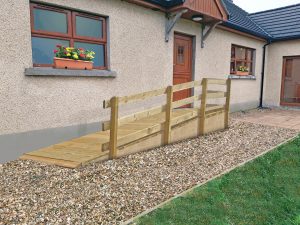How modifications to your environment can help you stay in your home
As we hear often, Parkinson’s disease (PD) affects every person differently. Because of this, it is very difficult to predict how any individual’s PD will progress. This may create a source of stress as people with PD and their care partners begin to contemplate the future. They may ask themselves: “What is in store for us? Will we be able to stay in our home? What options are there if we need more help?”
Although this is a very complex set of questions, you can empower yourself by learning about services that are available to help you or your loved one as PD progresses. This includes help with home modifications. An occupational therapist (OT) with specialized training in home accessibility can help you stay in your house safely.
Partnering with a Occupational Therapist
One such occupational therapist is Megan Rochford, MS, OTL, Specialty Certification in Environmental Modifications (SCEM), Certified Aging in Place Specialist, (CAPS), who works at Rusk Rehabilitation, NYU Langone Health, in New York City. She runs a unique program at Rusk known as Barrier-Free Design.
Recently, I was able to ask Ms. Rochford about her work.
1) What is Barrier-Free design?
Barrier-Free Design is an individualized plan to increase the accessibility and safety of an individual’s home environment. This can include structural changes to the home as well as the use of equipment to aid in the performance of daily tasks. As an OT, I evaluate the person, their home environment, and the activities he/she wants and needs to perform. Because I understand the medical conditions of the people I am evaluating, I am not only planning for their current needs but am thinking and planning for their possible future needs. When collaborating with an architect and/or contractor on more complex home modifications, I view myself as a bridge between the patient and the home builder. I am able to speak both of their languages, so I can help design the environment to maximize the person’s function.
2) Is this a service that is widely available in occupational therapy departments? If not, are there other ways to access similar services?
While all OTs can assist with some level of home safety issues as well as durable medical equipment (e.g. shower chair), I am not aware of too many OT departments in major medical centers that have an in-depth program like Barrier-Free Design. However, an OT who works in private practice would be able to help and recommend equipment and modifications that can make a difference. When it comes to more complex home modifications that is when you would want to work with an OT who specializes in home accessibility. There are OTs who specialize in home accessibility and work in private practice. An individual can contact the American Occupational Therapy Association to obtain a list of practitioners’ names who specialize in home accessibility in a particular area.
3) What are the most common types of home modifications that you recommend for Parkinson’s patients?
Access into and out of the bathroom and into and out of the home are the reasons for the majority of
4) What was the most complex home modification that you recommended/designed?
Many modifications we recommend and make are fairly standard and commonly implemented. But the most complex modification that I assisted with was the construction of a new home for a person using a wheelchair. We needed to address access into and out of the home, access between the floors of the home, as well as access and use of the kitchen, bedroom and bathroom. This was a collaboration between the patient, family, architect and builder. The group worked together in order to meet the unique needs of the individual.
5) How do people finance these home modifications?
There are a few ways in which people finance home modifications. Medical insurance will pay for some equipment such as durable medical equipment for showering and toileting, which is great because these items can really make a noticeable difference for people with PD. When it comes to more complex equipment, insurance coverage is not guaranteed and justification for the equipment is typically required. Structural modifications to a home are usually not covered by insurance. When financing structural modifications, individuals are either paying out of their own pocket or applying for financial assistance through community resources. If a person has long-term care (LTC) insurance, I always recommend speaking with the LTC provider to obtain information on what the policy would cover. Lastly, if the individual is a veteran, the Veteran’s Association may assist with funding.
Tips and Takeaways
- Modifications to your house or apartment can help keep you safe and enable you to remain in your home longer.
- Occupational therapists who specialize in home modifications can assess your home environment and your functional needs.
- Home modifications may be as simple as installation of grab bars in the bathroom and as complex as re-designing an entire house.
- To find an occupational therapist near you who specializes in home modification, you can contact the American Occupational Therapy Association.
- Speak to your neurologist about any home safety concerns you may have or any issues you have in navigating daily life in your home.
